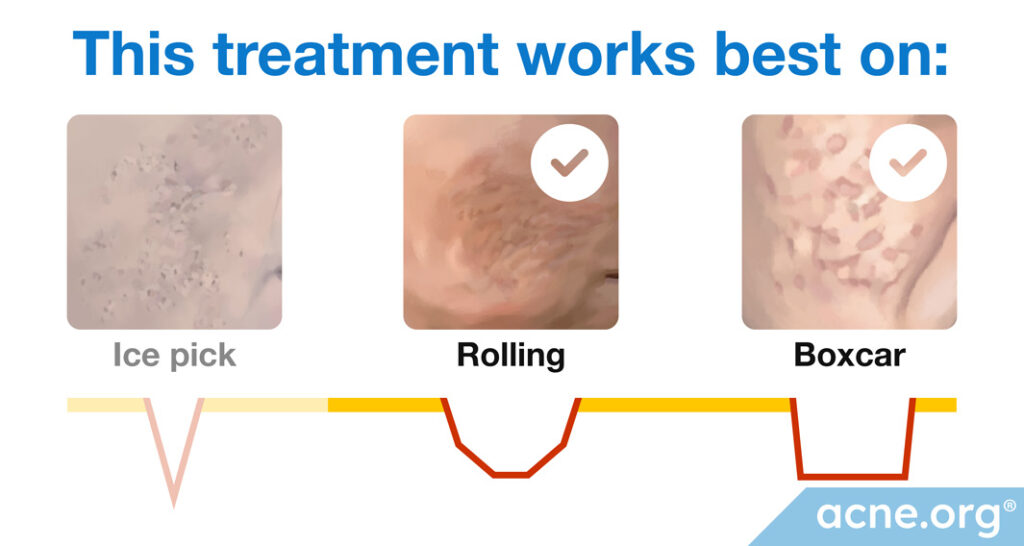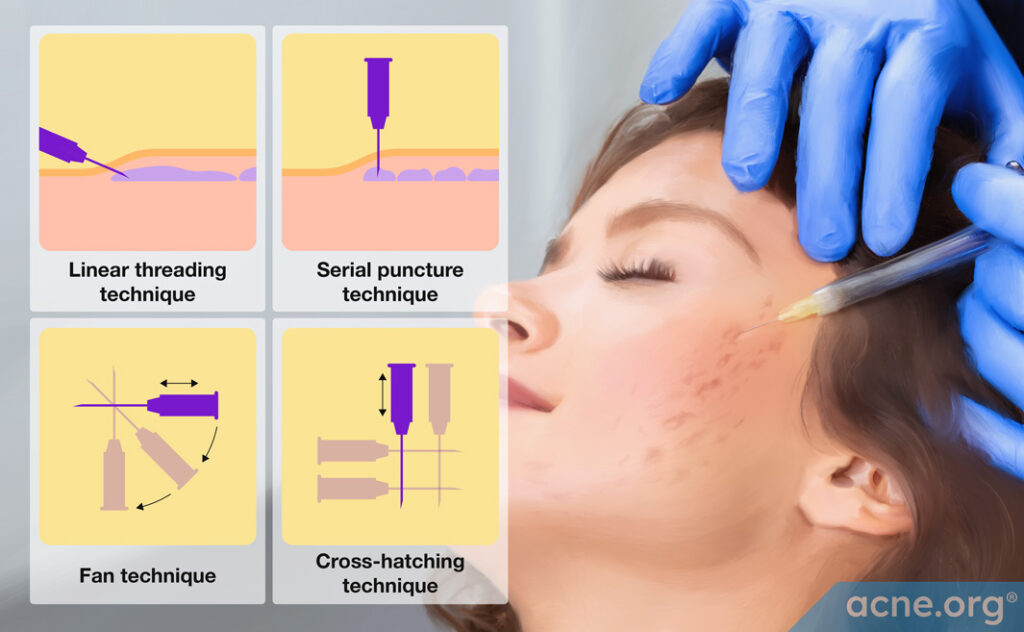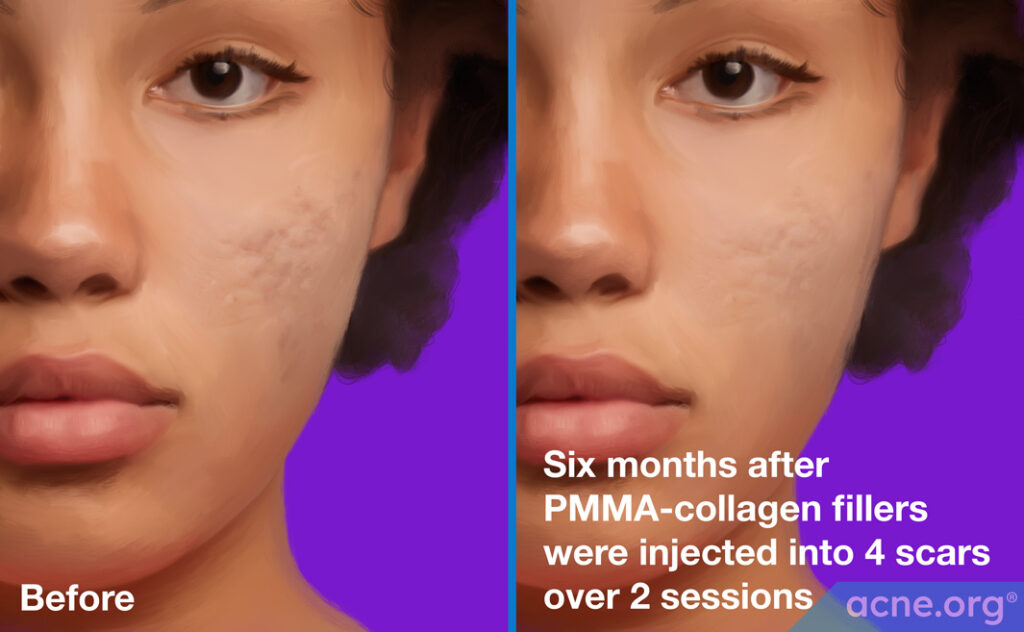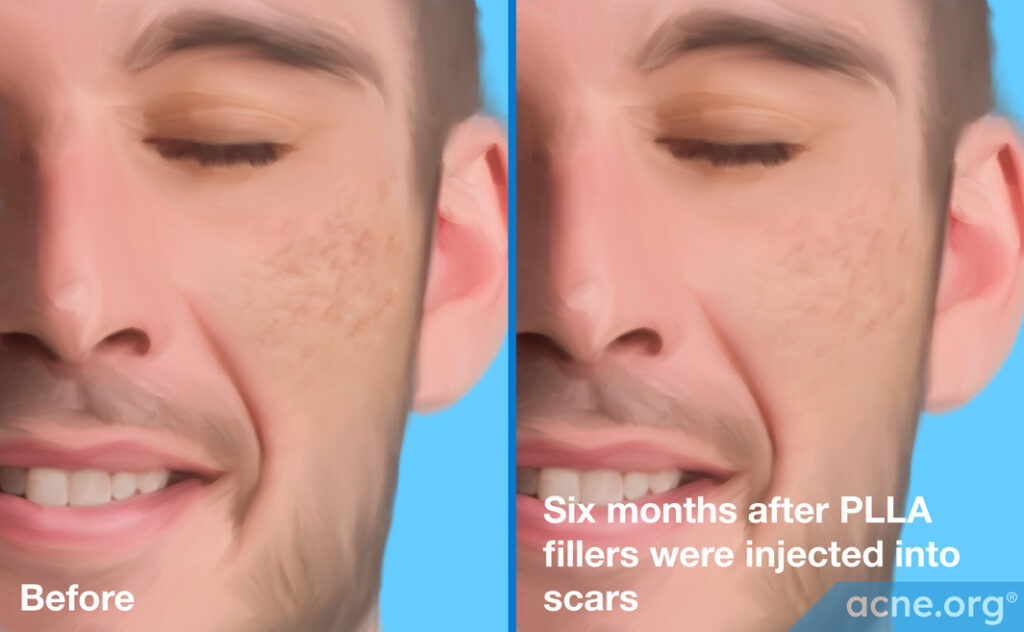
* Augmentation works best for rolling and boxcar scars.
Augmentation / Fillers is a mildly painful procedure in which a doctor injects a so-called dermal filler (literally a skin filler) underneath an atrophic (indented) scar to help build up the skin underneath an indented scar and even out the skin surface.
Fillers work in two ways:
- Physically taking up space: Dermal fillers physically fill up space underneath the scar.
- Stimulating collagen production: Dermal fillers stimulate the skin to produce collagen underneath the scar.1
Dermal fillers can be short-term or long-term and fall into 3 types, depending on how long they last:
- Temporary fillers: These fillers last up to 18 months in the skin. Over time, the body breaks down the filler and removes it from the skin.
- Semi-permanent fillers: These fillers last up to 2 years in the skin. Over time, the body breaks down the filler and removes it from the skin.
- Permanent fillers: These fillers can potentially last a lifetime. The body cannot break down the filler, which means that it stays in the skin permanently.2,3
An advantage of temporary and semi-permanent fillers is that, if you are dissatisfied with the results of the treatment, you know the effect of the filler will gradually decrease and eventually disappear. On the other hand, if you do like the results of the treatment and want to maintain the improvement, you will have to undergo augmentation again once the effect wears off.
With permanent fillers, no touch-up treatments will be necessary, but any undesirable results will also be permanent.
NOTE: Doctors recommend using a non-permanent filler the first time you undergo augmentation.4
As with all scar repair treatments, augmentation is sometimes combined with other scar repair procedures to achieve desired results.
People with active acne should not undergo acne scar revision of any kind, including augmentation. Make sure your skin is clear of acne before beginning scar treatment.
Before agreeing to undergo augmentation, talk to multiple doctors about their opinions, proposed treatments, expected outcomes, and prices.
Procedure details:
Many types of temporary, semi-permanent, and permanent fillers are available for augmentation.
- Filler Type:
- Temporary fillers:
- Hyaluronic acid (HA) fillers: HA is a natural component of the skin
- How it works:
- Fills up space in the skin
- Attracts water to add even more volume
- Stimulates collagen production (only if injected into deep layers of skin)2,10
- Effect duration:
- 6-12 months
- Trade names:
- Belotero®
- Captique®
- Esthélis®
- Elevess®
- Hylaform®
- Juvéderm®
- Perlane®
- Prevelle®
- Puragen®
- Restylane®
- Notes: HA is popular because of the low risk of side effects.4
- How it works:
- Collagen-based fillers: Collagen is a natural component of the skin. Collagen in fillers may come from animals (“bovine collagen” from cows or “porcine collagen” from pigs) or may be synthesized in a lab.
- How it works:
- Mimics the skin’s natural collagen and fills up space in the skin.
- Effect duration:
- 3-18 months
- Trade names:
- Bellafill®
- CosmoDerm®
- CosmoPlast®
- Zyderm®
- Zyplast®
- Notes: Collagen-based fillers are no longer recommended and are rarely used.3
- How it works:
- Hyaluronic acid (HA) fillers: HA is a natural component of the skin
- Semi-permanent fillers:
- Poly-L lactic acid (PLLA) fillers: PLLA is a synthetic polymer (large molecule made up of many repeating units) that the body gradually breaks down.
- How it works:
- Causes a subclinical (small) inflammatory reaction in the skin, which stimulates the skin to produce collagen.
- Effect duration:
- 9-24 months*
* This depends on how quickly the individual patient’s body breaks down the PLLA.4
- 9-24 months*
- Trade names:
- Sculptra® (Newfill®)
- How it works:
- Calcium hydroxylapatite (CH) fillers: CH is a crystal mineral. CH fillers consist of CH microspheres in a water-like gel.
- How it works:
- The body breaks down the gel, leaving the CH microspheres. CH microspheres stimulate the production of collagen.
- Effect duration:
- 12-18 months
- Trade names:
- Radiesse®
- How it works:
- Platelet-rich fibrin matrix (PRFM)/Platelet-rich plasma (PRP): PRFM/PRP is made by spinning the patient’s own blood in a centrifuge to separate out the platelets (cell fragments that participate in blood clotting).
- How it works:
- PRFM/PRP contains growth factors (natural molecules that trigger tissue growth). These growth factors stimulate the production of collagen.5
- Effect duration:
- 3 months to years
- Trade names: Not applicable
- Notes: More research is necessary to determine whether PRFM fillers are safe or effective for acne scar treatment.4
- How it works:
- Autologous (patient’s own) fat: Autologous fat is fat harvested from a different part of the patient’s own body.
- How it works:
- Initially, fat fills up space inside the skin. The skin gradually reabsorbs some of the fat cells.
- Effect duration:
- Months to years
- Trade names: Not applicable
- Notes: The autologous fat is usually combined with PRP for acne scars treatment.4-6
- How it works:
- Poly-L lactic acid (PLLA) fillers: PLLA is a synthetic polymer (large molecule made up of many repeating units) that the body gradually breaks down.
- Permanent fillers:
- Polymethylmethacrylate (PMMA) fillers: PMMA is a synthetic compound. PMMA fillers consist of:
- PMMA microspheres in a water-based gel
- 3.5% bovine (cow) collagen
- 0.3% lidocaine (an anesthetic)
- How it works:
- Initially, collagen fills up space under the scar. Over 1-3 months, the body breaks down the collagen, leaving the PMMA microspheres. PMMA microspheres cause a subclinical (small) inflammatory reaction in the skin, which stimulates the skin to produce collagen.4
- Effect duration:
- Permanent
- Trade names:
- Bellafill®
- Artefill®
- Notes: PMMA is the only injectable permanent filler approved by the U.S. Food and Drug Administration (FDA) for treating acne scars. It was approved in January 2015.2
- Polyalkylimide and polyacrylamide fillers: These fillers consist of polymers (large molecules made up of many repeating units) in a water-based gel.
- How it works:
- The fillers take up space and are eventually surrounded by collagen, becoming a permanent part of the skin.4
- Effect duration:
- Permanent
- Trade names:
- Bio-Alcamid®
- Aquamid®
- Notes: There are no studies testing these permanent fillers on acne scars.2
- How it works:
- Silicone fillers: Silicone is a rubbery synthetic compound.
- How it works:
- The fillers take up space and are eventually surrounded by collagen, becoming a permanent part of the skin.4
- Effect duration:
- Permanent
- Trade names: Not applicable
- Notes: Due to concerns about the safety of silicone fillers, these fillers have not been sufficiently tested on patients.2 They are not recommended.
- How it works:
- Polymethylmethacrylate (PMMA) fillers: PMMA is a synthetic compound. PMMA fillers consist of:
- Temporary fillers:
The doctor may use one of four techniques to inject the filler into the skin:4

- Linear threading: The doctor inserts the needle into the skin and then pulls it out slowly while injecting filler in a straight line. Alternatively, the doctor inserts the needle into the skin, and then begins injecting filler in a straight line while slowly continuing to insert the needle deeper into the skin.
- Serial puncture: The doctor inserts the needle into the skin, injects a small amount of filler, then pulls the needle out and inserts in a nearby location. A small amount of filler is injected at each insertion site. Sometimes, a single small injection is enough, but often, a series of punctures is necessary.
- Fanning: This technique is an extension of linear threading. The doctor performs linear threading, then, without pulling the needle out, redirects the needle in a different direction and performs linear threading again. This is repeated multiple times. Doctors use this technique to treat large areas of skin.
- Cross-hatching: The doctor performs a series of parallel linear injections, then performs another series of linear injections perpendicular to the first set of injections. This technique is used for treating large areas of skin.
Anesthesia:
Filler injection can be mildly painful, so your doctor will probably use one of the following methods to numb your skin:
- Apply a topical anesthetic, such as a cream containing the numbing medication lidocaine, to your skin before the treatment.
- Adding a numbing medication such as lidocaine directly to the syringe containing the filler, so that when the filler is injected, the skin will be numbed at the same time.8-10
Before-and-after:

Acne scars before (left) and 6 months after (right) PMMA-collagen fillers were injected into 4 scars over 2 sessions.

Acne scars before (left) and 6 months after (right) PLLA fillers were injected into scars.
References
- Levy LL, and Zeichner JA. Management of acne scarring, part II. A comparative review of non-laser-based, minimally invasive approaches. Am J Clin Dermatol. 13(5), 331-340 (2012).
- Forbat E, Ali FR, and Al-Niaimi F. The role of fillers in the management of acne scars. Clin Exp Dermatol. Apr 10 (2017). [Epub ahead of print]
- Wollina U, and Goldman A. Fillers for the improvement in acne scars. Clin Cosmet Investig Dermatol. 8, 493-9 (2015).
- Almukhadeb E, Binkhonain F, Alkahtani A, Alhunaif S, Altukhaim F, Alekrish K. Dermal Fillers in the Treatment of Acne Scars: A Review. Ann Dermatol. 35(6), 400-7 (2023).
- Almukhadeb E, Binkhonain F, Alkahtani A, Alhunaif S, Altukhaim F, Alekrish K. Dermal Fillers in the Treatment of Acne Scars: A Review. Ann Dermatol. 35(6), 400-7 (2023).
- Shetty VH, Bhandary SN, Bhandary R, Suvarna C. A comparative study of efficacy and safety of autologous fat grafting versus Platelet-rich plasma in the treatment of post-acne scars. J Cosmet Dermatol. 20(11), 3454-61 (2021).
- Tenna S, Cogliandro A, Barone M, Panasiti V, Tirindelli M, Nobile C, Persichetti P. Comparative Study Using Autologous Fat Grafts Plus Platelet-Rich Plasma With or Without Fractional CO2 Laser Resurfacing in Treatment of Acne Scars: Analysis of Outcomes and Satisfaction With FACE-Q. Aesthetic Plast Surg. 41(3), 661-6 (2017).
- Nilforoushzadeh MA, Heidari-Kharaji M, Alavi S, Nouri M, Nikkhah N, Jahangiri F, Mahmoudbeyk M, Peyrovan A, Baiat Tork B, Torkamaniha E, Zare S. Transplantation of autologous fat, stromal vascular fraction (SVF) cell, and platelet-rich plasma (PRP) for cell therapy of atrophic acne scars: Clinical evaluation and biometric assessment. J Cosmet Dermatol. 21(5), 2089-98 (2022).
- Nofal E, Helmy A, Nofal A, Alakad R, and Nasr M. Platelet-rich plasma versus CROSS technique with 100% trichloroacetic acid versus combined skin needling and platelet rich plasma in the treatment of atrophic acne scars: a comparative study. Dermatol Surg. 40(8), 864-73 (2014).
- Munavalli GS, Smith S, Maslowski JM, and Weiss RA. Successful treatment of depressed, distensible acne scars using autologous fibroblasts: a multi-site, prospective, double blind, placebo-controlled clinical trial. Dermatol Surg. 39(8), 1226-36 (2013).
- Sapra S, Stewart JA, Mraud K, and Schupp R. A Canadian study of the use of poly-L-lactic acid dermal implant for the treatment of hill and valley acne scarring. Dermatol Surg. 41(5), 587-94 (2015).
- Karnik J, et al. A double-blind, randomized, multicenter, controlled trial of suspended polymethylmethacrylate microspheres for the correction of atrophic facial acne scars. J Am Acad Dermatol.71(1), 77-83 (2014).
Future reading
- Mehrabi J, Shehadeh W, Gallo ES, Artzi O, Horovitz T. Comparison of 2 Hyaluronic Acid-based Fillers for the Treatment of Acne Scars: Structural Lifting Versus Biostimulatory Effect. Dermatol Surg. 49(6), 581-6 (2023).
- Han X, Ji D, Liu Y, Hu S. Efficacy and Safety of Transplantation of Autologous Fat, Platelet-Rich Plasma (PRP) and Stromal Vascular Fraction (SVF) in the Treatment of Acne Scar: Systematic Review and Meta-analysis. Aesthetic Plast Surg. 47(4), 1623-32 (2023).
 Acne.org Products
Acne.org Products